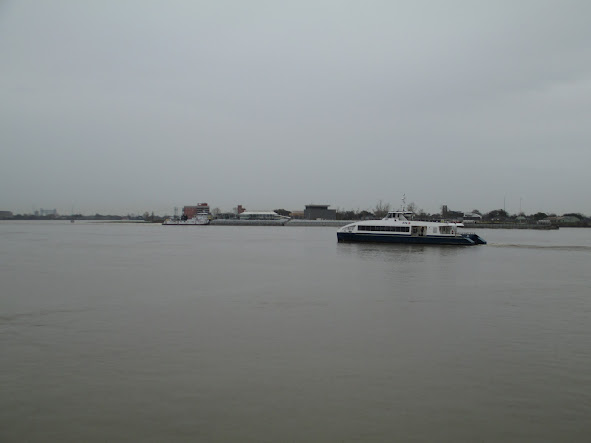The Canal Street-Algiers Point Ferry is one of two crossings
of the Mississippi River located at downtown New Orleans, connecting the foot
of Canal Street in town with the Algiers Point section of the city on the river’s
west bank. Like its neighboring ferries downriver, this crossing requires the
payment of a toll and ferries depart from each landing every 30 minutes on most
days. Unlike the other ferries, this crossing is not open to vehicles and is a
pedestrian-only river crossing. The ferry is located at the deepest part of the
Mississippi River, where the depth is about 210 ft across from Jackson Square.
At this point, the typical flowrate is 600,000 cubic feet per second. That
volume is roughly the equivalent of seven Olympic-sized swimming pools for
every second that passes.
The initial French settlement of New Orleans in 1718
was centered around what’s now Jackson Square and the historic French Quarter
neighborhood in the city. The area around Algiers Point was first developed as
a plantation in 1719 and an informal ferry service was started and remained
present in the following 100 years. The commercialization of the ferry service
at this location was made official in 1827, making this ferry one of the
longest-running commercial operations on the Mississippi River. The ferry became
essential as time went on, as Algiers grew in the 19th Century as
its own community, and following the annexation of the area into the city of
New Orleans in 1870. It was not until the 1950s when the construction of the Greater
New Orleans Bridge (nowadays known as the Crescent City Connection) enabled residents
to directly access both sides of the city by vehicle.
Algiers is sometimes also known as the 15th
Ward, one of the city’s 17 Wards and the only such subdivision located on the
west bank of the river, while downtown and the remainder of the city
limit is located on the river’s east bank. Since the Mississippi River flows due
north for a substantial distance in this area, an anomaly along the lower river,
the river’s west bank is in fact located compass east of downtown and the river’s
east bank, and vice versa.

The Canal Street Ferry operates on a passenger-only catamaran-style vessel like the one pictured here bound for the Algiers ferry terminal.
This ferry is my personal favorite of the services on
the lower Mississippi River. The ride across the river affords passengers the
opportunity to take in the sweeping views of downtown, the French Quarter, and
the Crescent City Connection and along with the city’s famous streetcar lines,
is a quintessential New Orleans transportation experience that should not be
passed up if you ever get the chance to visit.
The following pictures from my visits to the Canal Street Ferry in February 2024 showcase the Algiers Point Ferry Terminal on the west bank of the Mississippi River in the historic Algiers Point neighborhood of New Orleans. Click on each photo to see a larger version.
How To Get There:
Bridges, Crossings, and Structures of the Lower Mississippi River
Next Crossing upriver: Crescent City Connection Bridge (New Orleans, LA)
Next Crossing downriver: Chalmette-Lower Algiers Ferry (Chalmette, LA)
Return to the Bridges of the Lower Mississippi River Home Page
__________________________________________________






































Comments